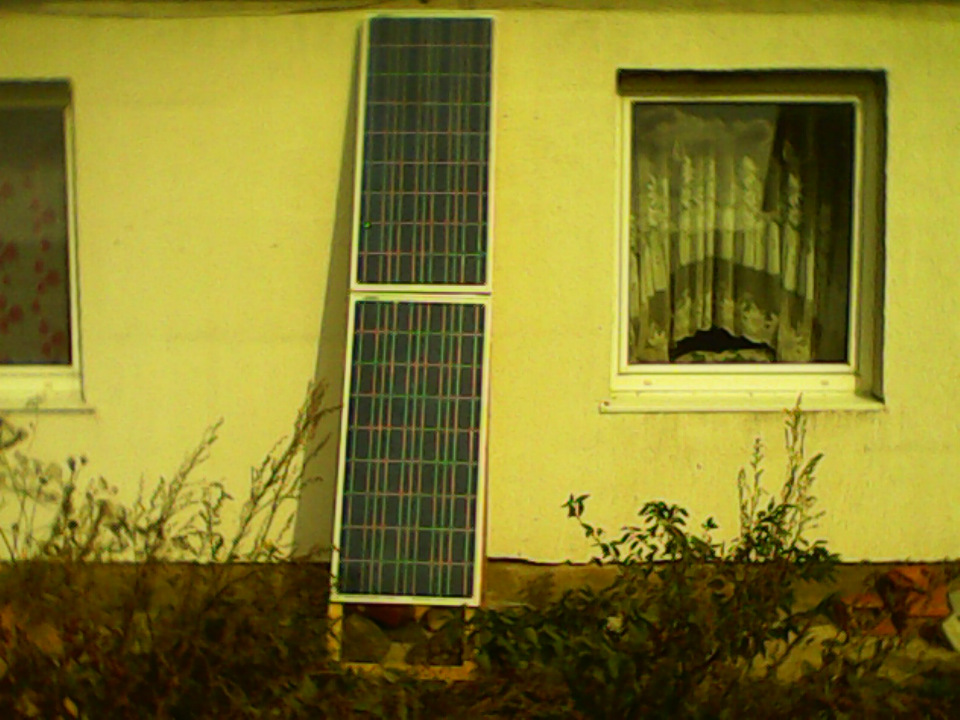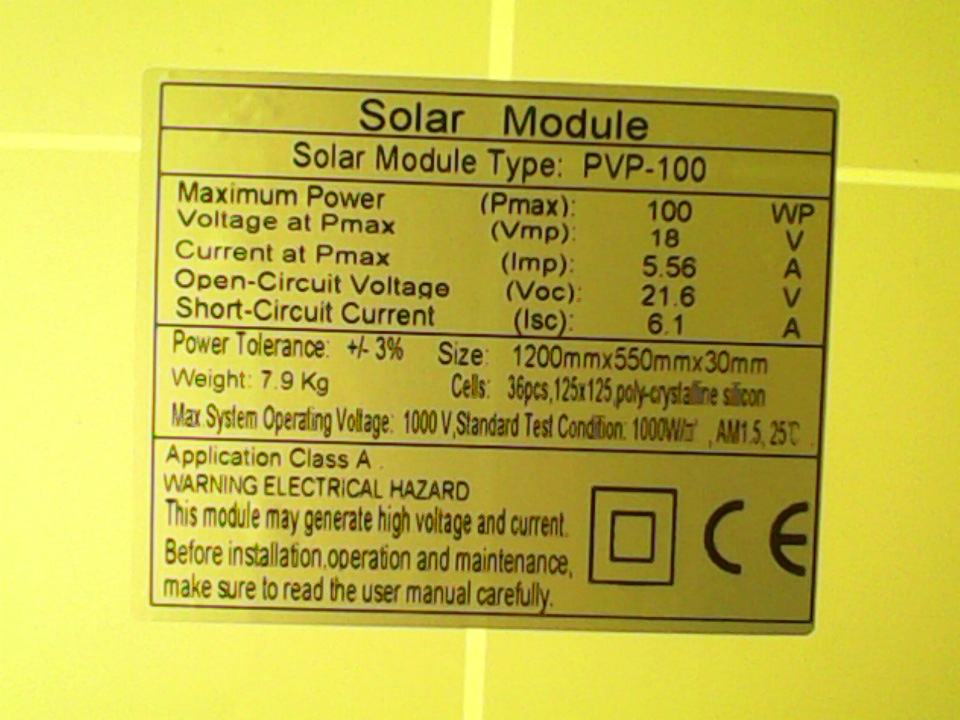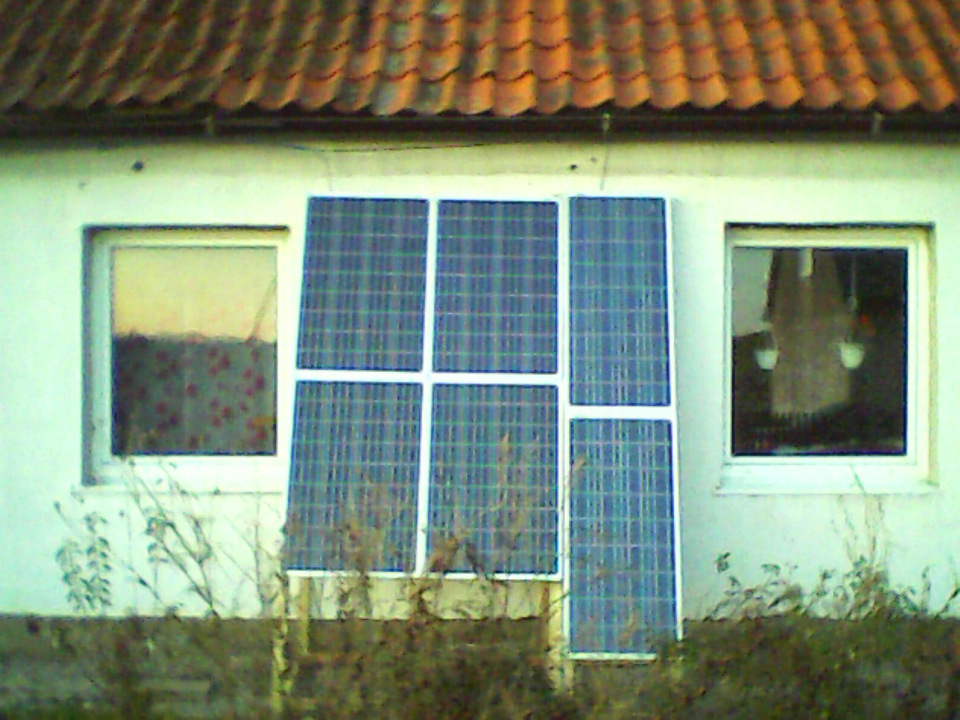"Chubais to himself" or alternative energy in the village
Good day, dear Khabrovchians! My article today will be devoted to the topic of "alternative energy" - more precisely, the power supply system of a rural house from solar panels.
I’m not some kind of “Greenpeace bruised all over” who doesn’t live in the world from what cutlets are made of pigs. That’s why I took up alternative energy, I can say forcibly, seriously engaged in. "Children's games" in the form of buying and bringing to mind garden lanterns on solar panels that charge in the afternoon on a flower bed or on a fence, and are brought into the house in the evening to work nightlights - this has been since they started selling them in stores in a nearby town. Now I’ll tell you which garden lanterns are worth taking, and which are not worth it, and what needs to be done with those who have taken them to serve you for at least a couple of years.
Relatively speaking - garden solar lanterns for me are divided into four types according to two strictly defined signs.
The first sign, key to the health of the device.
1) With flooded transparent epoxy photoelectric panel.
Here is a photo of the most typical representative of this "breed".

As the saying goes - “In all the shops of your city!”
Everything seemed to be fine - the solar panel is protected from everything and everything, use it and enjoy it. But - in fact, it’s good to serve such a flashlight if the season, by next year with a probability of 146%, transparent filling of the photocell will lose transparency under the influence of environmental conditions. Even if you remove the flashlight into the pantry by removing the battery, it will still go to the trash.
2) With openly located photocells as on old calculators.
These are already worth looking at, since after a simple revision they can serve for several years.
The most typical representative, similar to the first.

Actually exactly the same as the first - "There is everywhere."
The simplest refinement of this device so that it lasts for at least one season is to glue a gap around the solar panel on the cover with transparent sealant. Otherwise, when it rains, water will freely penetrate under the solar panel and further into the device, onto a defenseless electronic board, a small tablet battery, flow through the LED and accumulate in a plastic shade. The circuit does not have the currents and voltages to make a colorful firework, but electrochemical corrosion quickly eats up the circuit - when you open a dead device, you will be pleased with green copper oxides.
A more complex refinement involves disassembling the device and coating the printed circuit board with electronic components with varnish to protect them from moisture. It is impossible to smear only the battery holder, it will still have to be replaced somewhere once a year. If you want “absolutely everything was cool” - it is advisable to place a bag of silica gel inside the device, which should be changed periodically. Then the transparent cover of the flashlight will not fog up when the temperature drops.
The second sign is responsible for the "consumer properties" of the device.
1) Type of batteries used.
Some solar lanterns use tablet batteries, while others use little and finger batteries, both types of Ni-Cd or Ni-MH. It is clear that the little finger or finger battery has a large capacity, and in addition to its replacement, as a rule, a complete disassembly of the device is not required, it has a battery compartment with a lid on the latch. While the flashlight with the "tablet" must be disassembled with a screwdriver in hand.
2) Size and quantity of solar cells.
The size of solar lanterns also varies, there are small and cheapest, and there are large enough, which have 2-3-4 brown amorphous silicon "calculator" type solar panels on the lid and a nickel metal hydride finger battery, usually 600 mAh.
Here is their brightest and most intelligent representative of those that have been in my hands.

As they say - “We must take it!”
The design allows you to install it on a peg that comes bundled in a box, or hang it by a ring, 3 solar panels, a finger-type battery and a convex mirror reflector in the lower part of the lampshade. Improvements are the same - sealing the lid, coating the board with varnish, silica gel and to your taste - replacing the white-blue LED with a white or white-yellow LED for a more pleasant spectrum for the eyes. It shines for a long time, it shines brightly, it looks beautiful, after improvements it serves for a long time, it is inexpensive.
This is all you need to know about solar garden lanterns to make the right choice and use it as a lighting fixture for a long time. I used such large flashlights as table lamps and nightlights for two years, and was pleased with the result. Although if you are a collector and simply collect these devices for the soul - my advice will extend the life of your "pets".
But the games ended when, as a result of a thunderstorm, a transformer burned out at the entrance to the village - the wires crossed the wind and the protection failed. There was no light in the village for a week - the electricians did not have a spare transformer and had to wait until it was brought. A week without light, no Emergency Situations Ministry drove us to a mobile diesel station - all the refrigerators melted, the incubators with eggs also “covered with a copper basin”, personally my damage amounted to about 20 thousand. After such a “peck of a roasted rooster below the belt behind” - I had to start building an autonomous energy system for such cases.
As a result of the analysis of costs and benefits of various options, I settled on photovoltaics. And I won’t hide it - my “peling” colleague, who has a YouTube channel, strongly motivated me to embark on this path:www.youtube.com/user/SolFanify and my site: peling.ru
At first I watched his videos - quite affordable and quite technically competent, then I read the forum of his site and publications about experiments with different devices related to alternative energy. Along the way, in practice, he started building his first solar system, which is still alive despite the past 3 years.
I started with the smallest possible and cheapest configuration. Two solar panels Exmork FSM-5P polycrystalline panels 12V 5 W, at that time they cost 900 r on the website invertory.ru. PWR Solar 80 12 / 24V 80A charge controller with Ali Chinese for 4 thousand rubles - I decided not to save immediately on the controller, it was painfully good according to reviews, a 12V 10 Ah battery from an uninterruptible battery and a DC-AC 12-220V 150 W car purchased at the flea market a year earlier. I had a battery and a converter, I bought MC4 connectors and splitters, the wires were also of sufficient cross section, and the whole system came out at that time - about 6-6.5 thousand per circle. You say - it is very expensive for a 10 W system! And, you will be right, and wrong at the same time. I still use the Solar 80 charge controller in my modern, powerful system.
I got my first 5 W solar panels “with adventure”. They refused to send them to me by the RF Post and sent to the TEC PEK. And they lost them. When the delivery time has expired, and the cargo was not monitored, I contacted the manager. Which turned out to be a young Moscow girl, who began to fend off "from some kind of beyond Moscow Ring Road", first in correspondence by mail, and then by phone! Even the threat of going to court did not help - the money was transferred, I had all the confirmations, but the goods were gone! It was only the appeal to her superiors that helped - I found the phone of a higher manager and called him, outlined the situation, sent me all the necessary screenshots and even a recording of the conversation with the impudent girl manager. I didn’t even have to threaten the court - the next day the panels were sent again with an apology and a request not to advertise what had happened.
Finally, the panels were received, everything was connected and the system took on this form, only the battery was small.

In the photo - further development of the system, the MonBat 170 Ah 12V AGM traction battery, the same Solat 80 on the bench, 25 mm2 of copper wire per controller and on the street - a pair of Singfo panels of 100 W 12V poly. The panels were bought on Ali with delivery from a warehouse in Russia and came out at 7 thousand apiece. At that time, on the FSM-100 W Inverters, Poly was imported in small batches, most were bought up by dealers or wholesale buyers in advance, and the rest were swept away in minutes. I had to buy Chinese and more expensive. They were sent by the same TK PEK, without a crate only in a cardboard box, but intact.

Those same panels, on a makeshift stand of 20x40 rails against the wall of the house. They are longer and narrower than 100 watts of the Exmork panel.
And here is a photo of their sticker with specifications.

The next iteration of the system was the purchase of an inverter for 12-220 V 1600 W. For financial reasons, I had to stop at the "beggarly version" of the company A-Electronics. Was purchased "Pure Sine" DUALDSL-12-3000 UPS s 13 TR together with delivery.
Here is his photo.

This inverter is positioned as an uninterruptible system for gas boilers and can operate in broadcast mode and charge the battery from the network, but it is possible to work as an inverter for alternative energy. As I actually used it. The device is not the ultimate dream, but for its price it has good functionality and still works after almost three years.
Here is a photo of the connected inverter in the test version.

He gives out 1600 W, when 1700 W of an oil heater is connected, the protection starts to peep. But so much I did not load it usually, to a kilowatt. One 170 Ah battery in my personal experience is about 1 kWh of stored power and is quite consistent with a couple of 100 watts of solar panels without undercharging or overcharging, exactly the same 10 watts panels with a 10 Ah battery of the first test system. Which now with the Chinese PWR 30A charge controller for 500 r with delivery "lives" in the chicken coop providing autonomous illumination to hens.
Photo:

Those same 5 W panels, the rest is inside.
Further, the system developed quantitatively, and then qualitatively.
Batteries and solar panels were added, this time only Exmork.

Here is a photo of their stickers.

First, 4 to 100 watts to a pair of those that already were, while I switched to a system of 24 volts. Already 2 batteries of 170 Ah were installed in series, the controller was reconfigured, the panels were switched over and the DUALDSP-24-3000 was purchased, which already quietly produces 2000 watts. The second inverter turned out to be a little worse, noisier fans, but it works and suits me for my money.
The next iteration of the extension is another 4 Exmork 100W poly panels; the 24V system is still the same. Now all 8 Exmork panels look at noon, the first two - at sunset.

They add charge to the battery in the evening when the sun "goes around the corner of the house."
In the final version I have 12 panels, 10 Exmork panels + 2 Singfo panels. 8 panels at noon, 4 at sunset, 2 batteries 170 Ah, PWR 80A charge controller and 2 kW inverter.
Here is a video about my solar system:
A story about the system itself.
The story about eliminating the effects of the storm when the panels were blown off, breaking the coasters and breaking the MC4 connectors. Fortunately, I have a stock.
In future plans, increasing the number of batteries so that there is "one 170 Ah per pair of 100 W panels" and the installation of 400 W of a Chinese wind turbine which has already been purchased, but has not yet been masted. There is a lot of work, this is not for screwing panels from the racks of the stand.
My system suits me and the cost of it too, given the regular blackouts in the village due to periodic accidents and some kind of work on the lines. I did not bother with an accurate calculation of the payback, but thanks to the solar system, which is actively used to power household appliances, I pay 500-600 r per month for light, while my neighbors pay 2.5 thousand for gas stoves. If you count 2000 r per month of savings - the payback period of the already invested is about 5 years, 3 years have already passed. And the main thing for me is that when there is no light in the village, I have it.
On this I will end my story, I hope it was interesting and useful to readers. Everyone who is interested - subscribe to my channel, there are the latest news and videos about my projects and reviews of interesting devices that can hardly be found in everyday life.
PS At the request of workers a list of equipment, prices and links.
Solar panels Exmork FSM-100 W Poly - about 4.5 tr units were last year, now generally 3800 p. I have 12 panels.
invertory.ru/product/sb-exmork-100-vatt-12v
PWR Solar 80 charge controller - on Ali I took it for 4.5 thousand with delivery to Russia by courier service, now 4000 rubles with delivery by Post. One was bought, it still works flawlessly.
en.aliexpress.com/item/Solar-Regulator-12V-24V-80A-PWM-With-Max-1920W-Solar-Panel-For-Solar-System-Controller-LCD/32226118331.html?spm=a2g0v.search0604. 3.56.7d2724c5pRKSfr & ws_ab_test = searchweb0_0,searchweb201602_5_10065_10068_319_317_10696_453_10084_454_10083_10618_10307_10301_537_536_10059_10884_10889_10887_321_322_10915_10103_10914_10911_10910,searchweb201603_52,ppcSwitch_0&algo_expid=bd4abdf9-acb4-47b1-8da1-80577b41e942-8&algo_pvid=bd4abdf9-acb4-47b1-8da1-80577b41e942&transAbTest=ae803_4
Контроллер заряда PWR 30A — купил пару по 500 р, один работает в курятнике второй тоже скоро приспособлю к делу. Но больше 20А я бы их не нагружал.
ru.aliexpress.com/item/10A-20A-30A-12-24-5/32968947170.html?spm=2114.13010708.0.0.353233edMJjYvb
Разъемы МС4 там-же где и панели брал по 80 р под 6 мм2 провода, сейчас они по 78 р за пару.
invertory.ru/product/konnektor-universalny
MC4 splitters - now at 494 r per pair, I bought from the calculation of switching pairs of panels between themselves on a wire of 6 mm2.
invertory.ru/product/mc4-y-konnektor
Inverters DUALSP-12-3000-UPS and DUALDSP-24-3000-UPS, both 13000 r each with delivery, one for 12 V 1600 W, the second 24 V 2000 W.
Description a-electronica.ru/dualdsp-12-3000-ups-specifications.html
Price a-electronica.ru/price.html Traction
batteries Monbat Megalight Power 170 Ah 12V AGM - - were bought at a local store on order for 17000 r per piece . It was bought 3.
Copper flexible wires 6 mm2 from the batteries to the controller, 25 mm2 wires from the controller to the batteries and to the jumpers between them, the terminals to the batteries were purchased at local stores.
I’m not some kind of “Greenpeace bruised all over” who doesn’t live in the world from what cutlets are made of pigs. That’s why I took up alternative energy, I can say forcibly, seriously engaged in. "Children's games" in the form of buying and bringing to mind garden lanterns on solar panels that charge in the afternoon on a flower bed or on a fence, and are brought into the house in the evening to work nightlights - this has been since they started selling them in stores in a nearby town. Now I’ll tell you which garden lanterns are worth taking, and which are not worth it, and what needs to be done with those who have taken them to serve you for at least a couple of years.
Relatively speaking - garden solar lanterns for me are divided into four types according to two strictly defined signs.
The first sign, key to the health of the device.
1) With flooded transparent epoxy photoelectric panel.
Here is a photo of the most typical representative of this "breed".

As the saying goes - “In all the shops of your city!”
Everything seemed to be fine - the solar panel is protected from everything and everything, use it and enjoy it. But - in fact, it’s good to serve such a flashlight if the season, by next year with a probability of 146%, transparent filling of the photocell will lose transparency under the influence of environmental conditions. Even if you remove the flashlight into the pantry by removing the battery, it will still go to the trash.
2) With openly located photocells as on old calculators.
These are already worth looking at, since after a simple revision they can serve for several years.
The most typical representative, similar to the first.

Actually exactly the same as the first - "There is everywhere."
The simplest refinement of this device so that it lasts for at least one season is to glue a gap around the solar panel on the cover with transparent sealant. Otherwise, when it rains, water will freely penetrate under the solar panel and further into the device, onto a defenseless electronic board, a small tablet battery, flow through the LED and accumulate in a plastic shade. The circuit does not have the currents and voltages to make a colorful firework, but electrochemical corrosion quickly eats up the circuit - when you open a dead device, you will be pleased with green copper oxides.
A more complex refinement involves disassembling the device and coating the printed circuit board with electronic components with varnish to protect them from moisture. It is impossible to smear only the battery holder, it will still have to be replaced somewhere once a year. If you want “absolutely everything was cool” - it is advisable to place a bag of silica gel inside the device, which should be changed periodically. Then the transparent cover of the flashlight will not fog up when the temperature drops.
The second sign is responsible for the "consumer properties" of the device.
1) Type of batteries used.
Some solar lanterns use tablet batteries, while others use little and finger batteries, both types of Ni-Cd or Ni-MH. It is clear that the little finger or finger battery has a large capacity, and in addition to its replacement, as a rule, a complete disassembly of the device is not required, it has a battery compartment with a lid on the latch. While the flashlight with the "tablet" must be disassembled with a screwdriver in hand.
2) Size and quantity of solar cells.
The size of solar lanterns also varies, there are small and cheapest, and there are large enough, which have 2-3-4 brown amorphous silicon "calculator" type solar panels on the lid and a nickel metal hydride finger battery, usually 600 mAh.
Here is their brightest and most intelligent representative of those that have been in my hands.

As they say - “We must take it!”
The design allows you to install it on a peg that comes bundled in a box, or hang it by a ring, 3 solar panels, a finger-type battery and a convex mirror reflector in the lower part of the lampshade. Improvements are the same - sealing the lid, coating the board with varnish, silica gel and to your taste - replacing the white-blue LED with a white or white-yellow LED for a more pleasant spectrum for the eyes. It shines for a long time, it shines brightly, it looks beautiful, after improvements it serves for a long time, it is inexpensive.
This is all you need to know about solar garden lanterns to make the right choice and use it as a lighting fixture for a long time. I used such large flashlights as table lamps and nightlights for two years, and was pleased with the result. Although if you are a collector and simply collect these devices for the soul - my advice will extend the life of your "pets".
But the games ended when, as a result of a thunderstorm, a transformer burned out at the entrance to the village - the wires crossed the wind and the protection failed. There was no light in the village for a week - the electricians did not have a spare transformer and had to wait until it was brought. A week without light, no Emergency Situations Ministry drove us to a mobile diesel station - all the refrigerators melted, the incubators with eggs also “covered with a copper basin”, personally my damage amounted to about 20 thousand. After such a “peck of a roasted rooster below the belt behind” - I had to start building an autonomous energy system for such cases.
As a result of the analysis of costs and benefits of various options, I settled on photovoltaics. And I won’t hide it - my “peling” colleague, who has a YouTube channel, strongly motivated me to embark on this path:www.youtube.com/user/SolFanify and my site: peling.ru
At first I watched his videos - quite affordable and quite technically competent, then I read the forum of his site and publications about experiments with different devices related to alternative energy. Along the way, in practice, he started building his first solar system, which is still alive despite the past 3 years.
I started with the smallest possible and cheapest configuration. Two solar panels Exmork FSM-5P polycrystalline panels 12V 5 W, at that time they cost 900 r on the website invertory.ru. PWR Solar 80 12 / 24V 80A charge controller with Ali Chinese for 4 thousand rubles - I decided not to save immediately on the controller, it was painfully good according to reviews, a 12V 10 Ah battery from an uninterruptible battery and a DC-AC 12-220V 150 W car purchased at the flea market a year earlier. I had a battery and a converter, I bought MC4 connectors and splitters, the wires were also of sufficient cross section, and the whole system came out at that time - about 6-6.5 thousand per circle. You say - it is very expensive for a 10 W system! And, you will be right, and wrong at the same time. I still use the Solar 80 charge controller in my modern, powerful system.
I got my first 5 W solar panels “with adventure”. They refused to send them to me by the RF Post and sent to the TEC PEK. And they lost them. When the delivery time has expired, and the cargo was not monitored, I contacted the manager. Which turned out to be a young Moscow girl, who began to fend off "from some kind of beyond Moscow Ring Road", first in correspondence by mail, and then by phone! Even the threat of going to court did not help - the money was transferred, I had all the confirmations, but the goods were gone! It was only the appeal to her superiors that helped - I found the phone of a higher manager and called him, outlined the situation, sent me all the necessary screenshots and even a recording of the conversation with the impudent girl manager. I didn’t even have to threaten the court - the next day the panels were sent again with an apology and a request not to advertise what had happened.
Finally, the panels were received, everything was connected and the system took on this form, only the battery was small.

In the photo - further development of the system, the MonBat 170 Ah 12V AGM traction battery, the same Solat 80 on the bench, 25 mm2 of copper wire per controller and on the street - a pair of Singfo panels of 100 W 12V poly. The panels were bought on Ali with delivery from a warehouse in Russia and came out at 7 thousand apiece. At that time, on the FSM-100 W Inverters, Poly was imported in small batches, most were bought up by dealers or wholesale buyers in advance, and the rest were swept away in minutes. I had to buy Chinese and more expensive. They were sent by the same TK PEK, without a crate only in a cardboard box, but intact.

Those same panels, on a makeshift stand of 20x40 rails against the wall of the house. They are longer and narrower than 100 watts of the Exmork panel.
And here is a photo of their sticker with specifications.

The next iteration of the system was the purchase of an inverter for 12-220 V 1600 W. For financial reasons, I had to stop at the "beggarly version" of the company A-Electronics. Was purchased "Pure Sine" DUALDSL-12-3000 UPS s 13 TR together with delivery.
Here is his photo.

This inverter is positioned as an uninterruptible system for gas boilers and can operate in broadcast mode and charge the battery from the network, but it is possible to work as an inverter for alternative energy. As I actually used it. The device is not the ultimate dream, but for its price it has good functionality and still works after almost three years.
Here is a photo of the connected inverter in the test version.

He gives out 1600 W, when 1700 W of an oil heater is connected, the protection starts to peep. But so much I did not load it usually, to a kilowatt. One 170 Ah battery in my personal experience is about 1 kWh of stored power and is quite consistent with a couple of 100 watts of solar panels without undercharging or overcharging, exactly the same 10 watts panels with a 10 Ah battery of the first test system. Which now with the Chinese PWR 30A charge controller for 500 r with delivery "lives" in the chicken coop providing autonomous illumination to hens.
Photo:

Those same 5 W panels, the rest is inside.
Further, the system developed quantitatively, and then qualitatively.
Batteries and solar panels were added, this time only Exmork.

Here is a photo of their stickers.

First, 4 to 100 watts to a pair of those that already were, while I switched to a system of 24 volts. Already 2 batteries of 170 Ah were installed in series, the controller was reconfigured, the panels were switched over and the DUALDSP-24-3000 was purchased, which already quietly produces 2000 watts. The second inverter turned out to be a little worse, noisier fans, but it works and suits me for my money.
The next iteration of the extension is another 4 Exmork 100W poly panels; the 24V system is still the same. Now all 8 Exmork panels look at noon, the first two - at sunset.

They add charge to the battery in the evening when the sun "goes around the corner of the house."
In the final version I have 12 panels, 10 Exmork panels + 2 Singfo panels. 8 panels at noon, 4 at sunset, 2 batteries 170 Ah, PWR 80A charge controller and 2 kW inverter.
Here is a video about my solar system:
A story about the system itself.
The story about eliminating the effects of the storm when the panels were blown off, breaking the coasters and breaking the MC4 connectors. Fortunately, I have a stock.
In future plans, increasing the number of batteries so that there is "one 170 Ah per pair of 100 W panels" and the installation of 400 W of a Chinese wind turbine which has already been purchased, but has not yet been masted. There is a lot of work, this is not for screwing panels from the racks of the stand.
My system suits me and the cost of it too, given the regular blackouts in the village due to periodic accidents and some kind of work on the lines. I did not bother with an accurate calculation of the payback, but thanks to the solar system, which is actively used to power household appliances, I pay 500-600 r per month for light, while my neighbors pay 2.5 thousand for gas stoves. If you count 2000 r per month of savings - the payback period of the already invested is about 5 years, 3 years have already passed. And the main thing for me is that when there is no light in the village, I have it.
On this I will end my story, I hope it was interesting and useful to readers. Everyone who is interested - subscribe to my channel, there are the latest news and videos about my projects and reviews of interesting devices that can hardly be found in everyday life.
PS At the request of workers a list of equipment, prices and links.
Solar panels Exmork FSM-100 W Poly - about 4.5 tr units were last year, now generally 3800 p. I have 12 panels.
invertory.ru/product/sb-exmork-100-vatt-12v
PWR Solar 80 charge controller - on Ali I took it for 4.5 thousand with delivery to Russia by courier service, now 4000 rubles with delivery by Post. One was bought, it still works flawlessly.
en.aliexpress.com/item/Solar-Regulator-12V-24V-80A-PWM-With-Max-1920W-Solar-Panel-For-Solar-System-Controller-LCD/32226118331.html?spm=a2g0v.search0604. 3.56.7d2724c5pRKSfr & ws_ab_test = searchweb0_0,searchweb201602_5_10065_10068_319_317_10696_453_10084_454_10083_10618_10307_10301_537_536_10059_10884_10889_10887_321_322_10915_10103_10914_10911_10910,searchweb201603_52,ppcSwitch_0&algo_expid=bd4abdf9-acb4-47b1-8da1-80577b41e942-8&algo_pvid=bd4abdf9-acb4-47b1-8da1-80577b41e942&transAbTest=ae803_4
Контроллер заряда PWR 30A — купил пару по 500 р, один работает в курятнике второй тоже скоро приспособлю к делу. Но больше 20А я бы их не нагружал.
ru.aliexpress.com/item/10A-20A-30A-12-24-5/32968947170.html?spm=2114.13010708.0.0.353233edMJjYvb
Разъемы МС4 там-же где и панели брал по 80 р под 6 мм2 провода, сейчас они по 78 р за пару.
invertory.ru/product/konnektor-universalny
MC4 splitters - now at 494 r per pair, I bought from the calculation of switching pairs of panels between themselves on a wire of 6 mm2.
invertory.ru/product/mc4-y-konnektor
Inverters DUALSP-12-3000-UPS and DUALDSP-24-3000-UPS, both 13000 r each with delivery, one for 12 V 1600 W, the second 24 V 2000 W.
Description a-electronica.ru/dualdsp-12-3000-ups-specifications.html
Price a-electronica.ru/price.html Traction
batteries Monbat Megalight Power 170 Ah 12V AGM - - were bought at a local store on order for 17000 r per piece . It was bought 3.
Copper flexible wires 6 mm2 from the batteries to the controller, 25 mm2 wires from the controller to the batteries and to the jumpers between them, the terminals to the batteries were purchased at local stores.
